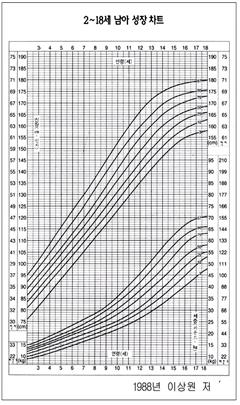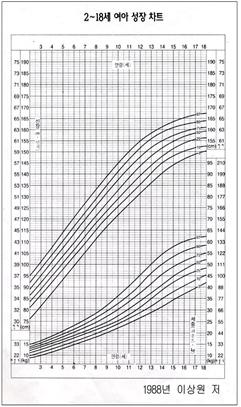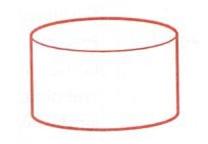9~10세 학령기 아이들과 초기 사춘기 아이들의 성장 발육, Growth and development of 9~10-year-old school children and early adolescents

그림 3-208. 2~18세 한국 남아들의 체중과 신장의 성장차트와 백분위수.
Copyright ⓒ 2012 John Sangwon Lee, MD., FAAP

그림 3-209. 2~18세 한국 여아들의 체중과 신장의 성장차트와 백분위수.
Copyright ⓒ 2012 John Sangwon Lee, MD., FAAP

그림 3-211. 9세 학령기 아이들의 대부분은 위 그림을 보고 그릴 수 있다.
Copyright ⓒ 2012 John Sangwon Lee, MD., FAAP
- 여기서는 후기 학령기 아이들과 초기 사춘기 아이들의 성장 발육에 관해 주로 설명한다.
- 학령기 아이들의 체중과 신장을 잰다.
- 측정한 체중치와 신장치를 성장차트 체중·신장 백분위선에 그려 넣고 성장차트의 백분위선 상 어디에 있는지 알아본다.
- 체중과 신장이 전과 거의 같은 성장차트 체중·신장 백분위선을 따라 계속 증가되면서 정상적으로 잘 자라나 알아본다.
- 신장과 체중이 가속도로 쑥쑥 크기 시작하고,
- 이차 성징이 나타나고,
- 아기를 생산할 능력이 생기고,
- 여아들의 몸은 성인 여성들의 몸 모양으로 변화되고,
- 남아들의 몸은 성인 남성들의 몸 모양으로 변화되고
- 골 성장이 점차로 중지되면서 신장과 체중의 성장도 점차로 중지되는 총 기간을 사춘기(Adolescence)라 한다.
- 이 기간에 아이들은 “사춘기 다리”를 지나 소아청소년들의 세상에서 성인들의 세상으로 가게 된다.
- 9~10세 학령기 남녀 아이들의 대부분에게 사춘기가 시작돼서 2차 성징이 나타나기 시작한다.
- 사춘기 아이들은 아이 세계에서 “사춘기 다리”를 건너 성인 세계로 가게 된다.
- 대부분의 여 사춘기 아이들은 9~11세 무렵에, 남 사춘기 아이들은 11~13세 무렵에 사춘기가 시작된다.
- 남아들의 사춘기는 여아들의 사춘기보다 1~2년 정도 늦게 시작한다.
- 사춘기가 시작되는 시기는 남아냐 여아냐에 따라 다르고, 각 아이에 따라 다르고, 인종과 집안 내력, 사는 지방과 나라, 영양 상태, 육체적 운동, 스트레스 등 여러 가지 요소에 따라 다를 수 있다.
- 그런 요소에 따라 여아의 초경이 좀 더 일찍 올 수 있고 늦게 올 수 있다.
- 초기 사춘기 아이들은 사춘기가 시작되기 전보다 그들의 일거일동을 조심히 자제한다.
- 그들의 독립 추구력이 더 강렬하고 독립된 한 개인으로 취급받기를 원한다.
- 그들에게 어떤 문제가 생기면 부모들이나 다른 사람들로부터 도움을 받아 해결할 수도 있지만,
- 다른 사람들의 도움을 받지 않고 그들 스스로 자기들에게 닥친 문제를 해결할 계획을 세우고 그 계획에 따라 해결하려는 경향이 더 뚜렷해진다.
- 그들은 자발적으로 일하고 스스로 쉬고, 공부하는 스케줄을 짜고 그 스케줄에 따라 일을 하는 초기 사춘기 아이들도 많다.
- 사춘기 초기의 아이들은 진실하고 솔직하고 정의와 사명감을 갖고 사회 생활하는 것이 일반적이다.
- 그들은 일반적으로 영웅심이 많다.
- 이 시기의 아이들의 대부분은 음식물을 먹는 태도가 바르고 깨끗이 먹고 잘 먹는다.
- 밤에 잠든 후 아침까지 한 번도 깨지 않고 계속 자는 것이 보통이다.
- 어른들의 인도에 잘 순종하고 사소한 집안일을 책임지고 혼자 잘 해낸다.
- 그렇지만 부모들이나 형제, 자매들이 그들이 원하는 것을 해주지도 않고 들어주지 않으면 몹시 기분이 상하는 것이 보통이다.
- 단체 활동이나 그룹 활동에서 남녀아의 역할이 뚜렷해진다.
- 만화책이나 실지로 일어난 사실에 관해 쓴 실화에 관한 책을 읽기 좋아한다.
- 연 월 일 시를 알 수 있고,
- 무거운 것과 가벼운 것을 확실히 분별할 수 있고,
- 간단한 곱셈과 나눗셈을 할 줄 안다.
- 대부분의 사춘기 여아들의 유방이 성인 여성들의 유방형태와 같이 커지고 발육되기 시작하고
- 엉덩이도 커지고 넓어지고
- 양 어깨는 둥글게 커진다.
- 사춘기 여아들에게 음모가 나기 시작하고 외음부도 성인 여성 외음부 형태와 같이 커지고 발육되기 시작한다.
- 사춘기 아이들, 사춘기 아이들의 2차 성징 참조.
| 9~10세 학령기~ 초기 사춘기 자녀를 사랑하기 |
- 9~10세 학령기 자녀들이나 초기 사춘기 자녀들은 부모의 눈길 접촉사랑, 신체적 접촉사랑, 집중적, 관심적 사랑과 보살핌을 그 어느 때보다 더 많이 받아야만 정신적으로 육체적으로 건전하게 성장한다.
- 특히 아버지로부터 받는 사랑은 더욱 그들의 건전한 자부심을 심어 주고 길러주는 데 도움이 된다.
- 그런 사랑을 해주는 데는 조건도 없고 적절하게 해야 한다.
- 그런 조건 없고 진정한 사랑을 많이 받아야 한다.
- 또 끊임없이 받아야 한다.
- 훈련을 사랑으로 해주어야 한다.
- 그들이 가지고 있는 사랑 탱크 속을 조건 없고 진정한 사랑으로 철철 넘치도록 채워주어야 한다.
- 그들이 험난한 세상에서 성장 하는 동안, 소외당할 때, 외로울 때, 불의와 싸울 때, 병마에 시달릴 때, 모욕을 당할 때, 목적 달성을 위해 분투할 때 부모로부터 받은 조건 없는 사랑을 에너지 자원으로 쓸 것이다.
- 엄마 아빠는 자녀들의 사랑 탱크 속을 가득히 채워 줄 의무와 권리를 가지고 있다.
- 자녀는 돈보다 명예보다 기업보다 재벌보다 이 세상 그 무엇보다 제일가는 우선이다.
- 자녀보다 더 귀중한 것은 이 세상에 있는가.
- 조건 없고 올바른 사랑을 흠뻑 받고 자라야 그들은 자신을 사랑할 줄 알고 다른 사람을 사랑할 줄 알고 무엇을 하든 최선을 다하고 건전한 자부심을 가지고 산다.
- 그들은 부모의 소유물이 아니고 충수도 아니다.
- 그들은 독립된 한 개인이다.
- 그릇된 사랑-소유적 사랑, 역할 전도적 사랑, 유혹적 사랑, 대리적 사랑으로 자녀들을 길러서는 안 된다.
- 엄마 아빠!
- 나를 사랑하십니까?
- 나를 조건 없이 사랑하십니까?
- 그리고 나를 진심으로 사랑하십니까?
- 부모 여러분!
- 그들의 질문에 대한 답변은 무엇입니까?
- “아닙니다”. 아니면 “그렇다.” 입니까?
- 그렇지 않으면 “모르겠다.”라고 답변 하시겠습니까?
- 이런 질문을 받으시면 “그렇고말고”라고 답변을 즉시 하실 수 있습니까?
- 걱정하지 마십시오.
- 이 세상에는 완전한 부모도 없고 완전한 자녀도 없습니다.
- 부모 여러분!
- 최선을 다해 자녀를 사랑해 양육하십시오.
- 그 보상은 아주 크기 때문입니다.
Growth and development of 9-10-year-old school children and early adolescents

Figure 3-208. Growth charts and percentiles of weight and height for Korean boys aged 2 to 18 years old. Copyright ⓒ 2012 John Sangwon Lee, MD., FAAP

Figure 3-209. Growth charts and percentiles of weight and height for Korean girls aged 2 to 18 years. Copyright ⓒ 2012 John Sangwon Lee, MD., FAAP

Figure 3-211. Most 9-year-old school-age children can draw by looking at the picture above. Copyright ⓒ 2012 John Sangwon Lee, MD., FAAP
• This article mainly focuses on the growth and development of late school-age children and early puberty children.
• Weigh and measure school-age children.
• Draw the measured weight and height values on the weight and height percentiles of the growth chart and find out where they are on the percentiles of the growth chart.
• Weight and height continue to increase along with the weight and height percentiles of the growth chart, almost the same as before, and check if they are growing normally.
• Their height and weight begin to increase rapidly,
• secondary sexual characteristics appear;
• gain the ability to produce babies;
• Girls’ bodies change to those of adult women,
• Boys’ bodies change to those of adult males and
• Adolescence is the total period of gradual cessation of growth in height and weight with gradual cessation of bone growth.
• During this period, children cross the “puberty bridge” from the world of children and adolescents to the world of adults.
• secondary sexual characteristics begin to appear with the onset of puberty for most boys and girls aged 9-10 years.
• Adolescents cross the “puberty bridge” from the child world to the adult world.
• Puberty begins around the age of 9-11 for most girls, and around 11-13 for boys.
• Puberty in boys starts 1-2 years later than puberty in girls.
• The timing of the onset of puberty varies for both boys and girls, for each child, and can depend on a number of factors, including race and family history, region and country of residence, nutritional status, physical exercise, and stress.
• Depending on those factors, a girl’s menarche may come earlier or later.
• Early puberty children are more cautious than before the onset of puberty.
• Their desire for independence is stronger and they want to be treated as an independent individual.
• If they have any problems, they may be able to solve them with help from parents or others, but
• There is a greater tendency to develop a plan to solve the problems they face on their own without the help of others and to work according to that plan.
• There are many early adolescents who work voluntarily, rest on their own, make a study schedule, and work according to that schedule.
• It is common for children in early puberty to be sincere, honest, and have a sense of justice and mission in society.
• They are generally heroic.
• Most of the children at this age have a good eating attitude, eat clean and eat well.
• After going to bed at night, it is normal to go to sleep without waking up until morning.
• Obey the guidance of adults, take responsibility for small household chores, and do well alone.
• It is common, however, to be very offended when parents, brothers, and sisters do not do what they want and do not listen to them.
• The roles of boys and girls in group activities and group activities become clear.
• They like to read comic books or books about true stories written about real events.
• They can know the year, month, date, and time,
• Van clearly distinguish between heavy and light;
• Can do simple multiplication and division.
• Most adolescent girls’ breasts begin to grow and develop in the same way as adult women’s breasts.
• Buttocks get bigger and wider
• Both shoulders are rounded.
• Puberty girls begin to develop pubic hair and the vulva begins to grow and develop just like the adult female vulva.
• See Adolescent Children, Secondary Sexual Characteristics in Adolescent Children.
9-10 years old school-age to early puberty Loving children
• School-age children aged 9-10 or early adolescent children grow mentally and physically healthy only when they receive more than ever before their parents’ love of eye contact, love of physical contact, intensive, caring love and care.
• The love they receive, especially from their father, helps them instill and nurture more wholesome self-esteem.
• Giving such love is unconditional and must be done appropriately.
• You must receive a lot of true love without such conditions.
• You must also constantly receive.
• Training should be done with love.
• They need to fill the tank of love they have with unconditional and true love.
• They will use the unconditional love they receive from their parents as an energy resource when they grow up in a difficult world when they are marginalized, when they are lonely, when they fight injustice, when they get sick, when they are insulted, when they struggle to achieve their goals.
• Moms and Dads have the duty and right to fill their children’s love tanks.
• Children are more important than money, fame, corporations, or anything else in the world.
• Is there anything in this world more precious than children?
• When they grow up receiving unconditional and right love, they learn to love themselves, love others, do their best in whatever they do, and live with a healthy sense of pride.
• They do not belong to their parents and are not appendages.
• They are independent individuals.
• Children should not be raised in false love-possessive love, role reversal love, seductive love, or vicarious love.
Mom and dad!
• Do you love me?
• Do you love me unconditionally?
• And do you really love me?
• Parents!
• What are the answers to their questions?
• “no”. Or “Yes.” is it?
• If not, would you answer “I don’t know”?
• If you are asked this question, can you immediately answer “no”?
• Do not worry.
• There are no perfect parents and no perfect children in this world.
• Parents!
• Do your best to love and nurture your children.
• Because the rewards are huge.
출처 및 참조문헌
- Nelson Textbook of Pediatrics 22ND Ed
- The Harriet Lane Handbook 22ND Ed
- Growth and development of the children
- Red Book 32nd Ed 2021-2024
- www.drleepediatrics.com 제1권 소아청소년 응급 의료
- www.drleepediatrics.com 제2권 소아청소년 예방
- www.drleepediatrics.com 제3권 소아청소년 성장 발육 육아
- www.drleepediatrics.com 제4권 모유,모유수유, 이유
- www.drleepediatrics.com 제5권 인공영양, 우유, 이유식, 비타민, 미네랄, 단백질, 탄수화물, 지방
- www.drleepediatrics.com 제6권 신생아 성장 발육 육아 질병
- www.drleepediatrics.com제7권 소아청소년 감염병
- www.drleepediatrics.com제8권 소아청소년 호흡기 질환
- www.drleepediatrics.com제9권 소아청소년 소화기 질환
- www.drleepediatrics.com제10권. 소아청소년 신장 비뇨 생식기 질환
- www.drleepediatrics.com제11권. 소아청소년 심장 혈관계 질환
- www.drleepediatrics.com제12권. 소아청소년 신경 정신 질환, 행동 수면 문제
- www.drleepediatrics.com제13권. 소아청소년 혈액, 림프, 종양 질환
- www.drleepediatrics.com제14권. 소아청소년 내분비, 유전, 염색체, 대사, 희귀병
- www.drleepediatrics.com제15권. 소아청소년 알레르기, 자가 면역질환
- www.drleepediatrics.com제16권. 소아청소년 정형외과 질환
- www.drleepediatrics.com제17권. 소아청소년 피부 질환
- www.drleepediatrics.com제18권. 소아청소년 이비인후(귀 코 인두 후두) 질환
- www.drleepediatrics.com제19권. 소아청소년 안과 (눈)질환
- www.drleepediatrics.com 제20권 소아청소년 이 (치아)질환
- www.drleepediatrics.com 제21권 소아청소년 가정 학교 간호
- www.drleepediatrics.com 제22권 아들 딸 이렇게 사랑해 키우세요
- www.drleepediatrics.com 제23권 사춘기 아이들의 성장 발육 질병
- www.drleepediatrics.com 제24권 소아청소년 성교육
- www.drleepediatrics.com 제25권 임신, 분만, 출산, 신생아 돌보기
- Red book 29th-31st edition 2021
- Nelson Text Book of Pediatrics 19th- 21st Edition
- The Johns Hopkins Hospital, The Harriet Lane Handbook, 22nd edition
- 응급환자관리 정담미디어
-
소아가정간호백과–부모도 반의사가 되어야 한다, 이상원
-
Neonatal Resuscitation American heart Association
-
Neonatology Jeffrey J.Pomerance, C. Joan Richardson
-
Pediatric Resuscitation Pediatric Clinics of North America, Stephen M. Schexnayder, M.D.
-
Pediatric Critical Care, Pediatric Clinics of North America, James P. Orlowski, M.D.
-
Preparation for Birth. Beverly Savage and Dianna Smith
-
Infectious disease of children, Saul Krugman, Samuel L Katz, Ann A. Gershon, Catherine Wilfert
- 소아과학 대한교과서
- Growth and Development of Children, Eighth Edition, George H. Lowrey, Yearbook Medical Publishers
- Growth and Development of Children, Fifth Edition, E. H. Watson and G. H. Lowrey, Yearbook Medical Publishers
- Other
-
Copyright ⓒ 2015 John Sangwon Lee, MD, FAAP
미국 소아과 전문의, 한국 소아청소년과 전문의 이상원 저 “부모도 반의사가 되어야 한다”-내용은 여러분들의 의사로부터 얻은 정보와 진료를 대신할 수 없습니다.
“The information contained in this publication should not be used as a substitute for the medical care and advice of your doctor. There may be variations in treatment that your doctor may recommend based on individual facts and circumstances. “Parental education is the best medicine.”